Paint Additions Into GAC 800 for Pouring Applications
Several rounds of test mixtures of GAC 800 and GOLDEN paints.
By far, the most popular GOLDEN Acrylic Medium used for pouring paints is GAC 800. Our Heavy Body Acrylics, Fluid Acrylics, and High Flow Acrylic paint lines readily blend with this free-flowing medium. These mixtures will merge together well due to the uniform consistency and provide excellent control of line and edge. Because these paints are so highly pigmented, one only has to add a very small percentage to GAC 800 to yield vibrant color fields. When stronger color concentration or increased opacity is desired, higher amounts of paint may be added as needed.
A previous Just Paint article about Pouring mentions a 10:1 (GAC 800 to paint) ratio as a good starting point. At this level, the paint additions are not likely to alter the medium’s sheen, consistency, and inherent application properties. There’s no true right or wrong paint level when it comes to mixing into GAC 800. However, increasing the paint levels will eventually begin to impact the medium’s ability to flow and dry defect free. So the question becomes, “exactly how much paint can I add before GAC 800’s pouring ability is compromised?”
Being the ever-inquisitive paint geeks that we are around here, we set up some testing to help answer that question. Since each paint line has a defined set of properties, it was necessary to take a look at each of them separately. The same colors (Burnt Sienna, Carbon Black, Titanium White and Phthalo Blue / Red Shade) were used for each line, helping to reduce the variables. We also used ratios of paint to GAC 800 that went well beyond what we recommend for pouring as a way to establish an upper limit. However, each artist might want to do their own testing, especially if using colors beyond the ones we chose.
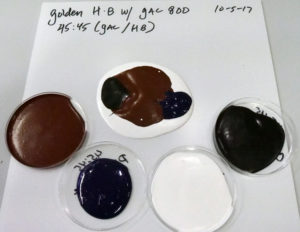
Heavy Body Acrylics
Heavy Body Acrylics are obviously much thicker than GAC 800, and when added at higher levels, can make it so thick that it will no longer pour. Each pigment possesses inherently unique properties which became obvious when testing a small set of four colors. Since paint formulas differ from one to other, you should test everything you would like to use to make sure it performs as expected. In the latest testing, each Heavy Body color still remained pourable at 2:1 (GAC 800 to Heavy Body), with some more pourable than others. At a 1:1 ratio (see image 1), all of the mixtures were unable to flow and level readily. They didn’t craze, but for pouring purposes, these ratios are not useful.
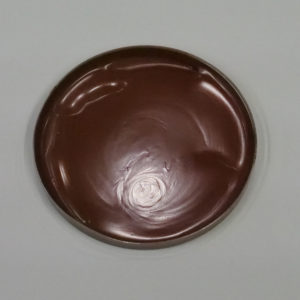
Fluid Acrylics
Fluid Acrylics are the closest paint line with the consistency of GAC 800. However, as more paint is added to the mixture, they start to behave differently. At a 1:1 ratio the paint sheen is affected, with bubbles less willing to come out and the retention of “motion lines” that result from how the product was applied. Also at these higher paint levels, puddles can create slight depressions, the beginning signs of crazing, along with the color borders (see image 2). Even single paint pours at these elevated levels are more likely to craze (see image 3).
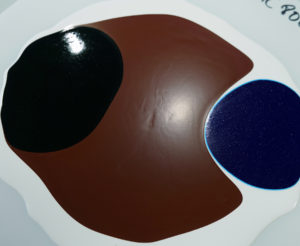
High Flow Acrylics
High Flow Acrylics are thinner than GAC 800, so mixtures become thinner and flow readily. At lower levels, this makes for some great blending and movement with little effort. As the paint levels are increased, the mixtures remain craze free, which makes sense when you consider that the pours are physically thinner and thus dry more uniformly throughout the entire paint film. Upon drying, it was noted that higher paint percentages developed surface defects. Some of the additives in the paint, even the pigment itself, can “kick out” and congregate on the paint surface. Retarders and surfactants were observed (see image 4). When these kinds of materials are allowed to remain on the surface, they can cause foaming and adhesion issues for subsequent paint layers, isolation coats, and varnish. Luckily most of these additives can be readily removed with a soft, damp cloth once the surface is fully dry. However, care must be taken as wiping a freshly painted surface could cause some color lift or surface abrasion. Ultimately, much of this is caused by pouring overly thick layers of paint. Backing off from higher additions of paint levels is the most direct way to avoid these issues.
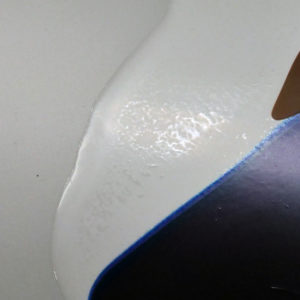
The Benefit of Increasing Paint amounts
Aside from the issues caused by increased percentages of paint, there are also benefits from these higher paint concentrations. Inherently transparent pigments – such as the entire Quinacridone family – appear more solid and opaque. When pouring solid color wet into wet, there is a cleaner, more distinct border between the pours. Lower ratios of paint with GAC 800 are more transparent and this causes more “ghosting” along the edge (see image 5). Ghosting also happens when paints are layered a bit too quickly or the surface isn’t level. If you desire very clean edges, allow each poured layer a little time to even out and stop spreading before the subsequent paint is drizzled on.
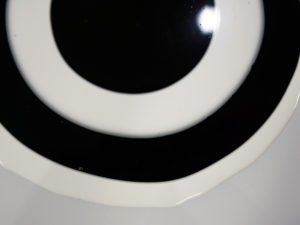
Stirred, Not Shaken
During testing, we commonly observe interesting, unexpected oddities. One such observation stemmed from shaking each of the paint and medium mixtures the day before applying them (see image 6). In each case, there were more foam bubbles than expected, especially when compared to mixtures that were stirred. After noting some unexpected surface defects in mixtures with Carbon Black, additional testing was conducted with the only difference between getting a smooth, uniform puddle of black and one that looks more like an old urban, sun-baked tar rooftop was that one trial was mixed by simply stirring and the other vigorously shaken. More testing is on the docket, but for now, I’ll take my pouring mixtures stirred, not shaken.
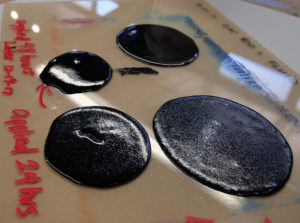
Conclusion
Overall, the main takeaway is to appreciate that lower paint additions, generally from 10:1 to 2:1, are more likely to maintain a uniform, glossy surface that is craze free with minimal differences from color to color. As the paint level increases, so will the differences of how each mixture flows and interacts with other mixtures.
For further reading, visit goldenpaints.com to review the GAC 800 Product Information Sheet. Call or email us at [email protected].
About Michael Townsend
View all posts by Michael Townsend -->Subscribe
Subscribe to the newsletter today!
No related Post

